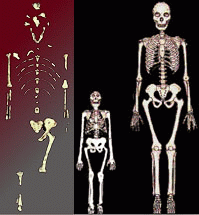




"Fragments of more than 300 individuals of Australopithecus afarensis have been discovered so far, including a remarkably complete skeleton of an adult female (nick-named 'Lucy') shown above. 'Lucy' was found in 1974 near Hadar in Ethiopia. Her skeleton has provided a wealth of information about the ancestral line of human beings, some of it quite surprising. The illustration above shows 'Lucy' in comparison with a modern human female. She was only about 3 feet, 8 inches tall. Males were somewhat taller and twice as robust."

"A. afarensis is classified as an ape, not a human. It is a Hominid -- that is, an ape closely related to human beings. In terms of overall body size, brain size and skull shape, 'Lucy' resembles a chimpanzee. However, A. afarensis has some surprisingly human characteristics. For example, the way the hip joint and pelvis articulate indicates that 'Lucy' walked upright like a human, not like a chimp. This means that upright posture and bi-pedalism preceded the development of what we would recognize as human beings and human intelligence. Above (right) is a reconstruction of Lucy's full skeleton."
"Until 1994, A. afarensis was the earliest Hominid species yet discovered. At that time, remains of another species, tentatively called Australopithecus anamensis, was discovered in the Lake Turkana region of east Africa and appears contemporary with afarensis, dating to approximately 4.2 million years ago. A. anamensis is also an erect, bi-pedal species, and its discovery pushes direct evidence of our distinctive Hominid form of locomotion back to over 4 million years ago. The first studies of this species are still in progress and more information will be forthcoming. There is evidence that, contrary to previous assumptions, these early Hominids had developed bi-pedalism prior to the disappearance of woodlands and forests in eastern Africa -- that is, our Hominid ancestors were by chance 'pre-adapted' to the conditions of drier, more open country that came to prevail in eastern Africa later on. Even more interesting is a discovery in 1995 in Ethiopia, at Aramis, just south of Hadar, of a creature possibly ancestral to A. afarensis. Its teeth and other bones are even more chimp-like than 'Lucy's' (A. afarensis). The species name for this creature is ramidus, after an Ethiopian word meaning 'root'. From the surviving bones, it is not possible to tell if ramidus was bi-pedal and therefore a Hominid australopithicine. It is still being intensively studied. Some scholars have proposed a new genus name, Ardipithecus, on the assumption that it was not bi-pedal. It appears that A. ramidus (whether properly named Ardipithecus or Australopithecus), lived in a forest environment."
"The last several years have thus produced several dramatic finds which are likely to modify our view of Hominid evolution significantly when their implications are more fully understood."
MORE (Lucy’s diet)
Washington State University